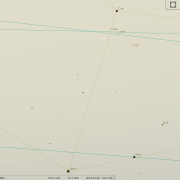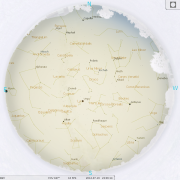In this month's edition
Planetary Skylights
 Jupiter finally succumbs to bright evening twilight and is lost to view towards the end of the month. Jupiter will return to the morning sky later next month.
Jupiter finally succumbs to bright evening twilight and is lost to view towards the end of the month. Jupiter will return to the morning sky later next month.
 Mars remains visible during the evenings low in the SW and is joined by the First Quarter moon on the 5th. On the 12th/13th Mars is in conjunction with Spica for the final time this year, after which it races away from the chief star in Virgo, continuing in prograde motion and heading in the direction of Saturn. Telescopically Mars appears rather small with just a hint of surface detail visible.
Mars remains visible during the evenings low in the SW and is joined by the First Quarter moon on the 5th. On the 12th/13th Mars is in conjunction with Spica for the final time this year, after which it races away from the chief star in Virgo, continuing in prograde motion and heading in the direction of Saturn. Telescopically Mars appears rather small with just a hint of surface detail visible.
 Saturn is well placed in the evening sky, visible across in the SSW midway between Mars and the conspicuous orange star Antares in Scorpius. Through a scope the stunning rings should be quite apparent - one of nature's finest sights. Look for Titan, Saturn's largest moon as a speck of light nearby, it circles round Saturn twice a month in an anti clockwise direction. Saturn lies near our moon on the 7th.
Saturn is well placed in the evening sky, visible across in the SSW midway between Mars and the conspicuous orange star Antares in Scorpius. Through a scope the stunning rings should be quite apparent - one of nature's finest sights. Look for Titan, Saturn's largest moon as a speck of light nearby, it circles round Saturn twice a month in an anti clockwise direction. Saturn lies near our moon on the 7th.

 Let us stay in the evening sky, and in the vicinity of Mars, where the two asteroids Ceres (left) and Vesta (right) lie very close to one another, particularly on the 4th. That evening they will be separated by just 10.5 arc minutes making a great target to view or image. Observe around 11pm when skies are sufficiently dark to pick them out and use the chart to help track them down, both should easily be within binocular (7x50 or 10x50 etc) range with Ceres at mag +8.4 and Vesta at mag +7.1. The pair cross paths later in the month, but Vesta will have pulled away from Ceres by then. (To locate Ceres and Vesta, see star char below)
Let us stay in the evening sky, and in the vicinity of Mars, where the two asteroids Ceres (left) and Vesta (right) lie very close to one another, particularly on the 4th. That evening they will be separated by just 10.5 arc minutes making a great target to view or image. Observe around 11pm when skies are sufficiently dark to pick them out and use the chart to help track them down, both should easily be within binocular (7x50 or 10x50 etc) range with Ceres at mag +8.4 and Vesta at mag +7.1. The pair cross paths later in the month, but Vesta will have pulled away from Ceres by then. (To locate Ceres and Vesta, see star char below)
 Mercury makes an appearance in the dawn sky after July 20th. Look for it low down in the NE just a few degrees above the horizon and lower left of much brighter Venus, which may serve as a guide. A slim crescent moon lies off to the right of Venus on the 24th. You will need to be up around 50 minutes before sunrise to spot them.
Mercury makes an appearance in the dawn sky after July 20th. Look for it low down in the NE just a few degrees above the horizon and lower left of much brighter Venus, which may serve as a guide. A slim crescent moon lies off to the right of Venus on the 24th. You will need to be up around 50 minutes before sunrise to spot them.
 Earth is at Aphelion (furthest from Sun) on July 4th, a distance of around 95 million miles (152 million km).
Earth is at Aphelion (furthest from Sun) on July 4th, a distance of around 95 million miles (152 million km).
 Next Moon Phases - 1st Qtr 5th Full 12th Last Qtr 19th New 26th
Next Moon Phases - 1st Qtr 5th Full 12th Last Qtr 19th New 26th
Meteor Watch

A number of lesser meteor showers occur during July.
- The Capri-Cornids have 3 maxima, July 8, 15, and 26, but all have Zenith hourly rates (ZHR) of only half a dozen -little more than sporadic rates.
- The Alpha-Cygnids peak on July 21 with rates between 5 and 10. Cygnus is well placed high in the SSE by midnight.
- The Delta-Aquarids are a little more prolific and peak on July 29th with a ZHR of round 15-20. The light conditions at this time of the year do mean observations are really limited to the period between midnight and 3am although brighter shooting stars may be spotted earlier.
July 2014 Sky Charts
|
|
Sky Chart for July 2014 |
Image Credits: NASA. Skynotes: Stellarium.
- Log in to post comments



